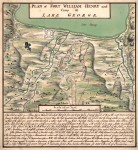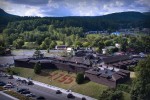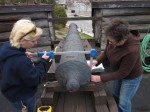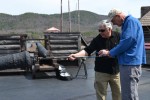 There are 49 replicas and 19 original historic cannons at the Fort William Henry Museum in the Adirondack town of Lake George, New York. The fort is itself a replica, built on the site of the original Fort William Henry, a British outpost from the Seven Years’ War. It was besieged by the French and their Indian allies in 1757 and was compelled to surrender when reinforcements were not forthcoming. Some of the surrendering prisoners were killed by Indian warriors disgruntled by the French prohibition that kept them from looting the defeated fort. It was widely publicized as a massacre at the time and figures as high as 1,500 slaughtered were bandied about in the immediate aftermath. The real number, modern historians believe, is more like 200 killed and wounded, about 7.5% of the prisoners. The siege of Fort William Henry played a central role in James Fenimore Cooper’s The Last of the Mohicans.
There are 49 replicas and 19 original historic cannons at the Fort William Henry Museum in the Adirondack town of Lake George, New York. The fort is itself a replica, built on the site of the original Fort William Henry, a British outpost from the Seven Years’ War. It was besieged by the French and their Indian allies in 1757 and was compelled to surrender when reinforcements were not forthcoming. Some of the surrendering prisoners were killed by Indian warriors disgruntled by the French prohibition that kept them from looting the defeated fort. It was widely publicized as a massacre at the time and figures as high as 1,500 slaughtered were bandied about in the immediate aftermath. The real number, modern historians believe, is more like 200 killed and wounded, about 7.5% of the prisoners. The siege of Fort William Henry played a central role in James Fenimore Cooper’s The Last of the Mohicans.
 Because of the popularity of the book, the famous massacre, the short but bloody history of the fort and its ideal location on a lake in the Adirondacks, the site of Fort William Henry became a tourist mecca. To take advantage of the historical tourism market, the replica was constructed in 1954 as full-scale copy of the original. To lend it authenticity, the owners of the attraction wanted some genuine Colonial artillery. Among the 19 antiques were nine cannons which had been salvaged a few years earlier in the Florida Keys.
Because of the popularity of the book, the famous massacre, the short but bloody history of the fort and its ideal location on a lake in the Adirondacks, the site of Fort William Henry became a tourist mecca. To take advantage of the historical tourism market, the replica was constructed in 1954 as full-scale copy of the original. To lend it authenticity, the owners of the attraction wanted some genuine Colonial artillery. Among the 19 antiques were nine cannons which had been salvaged a few years earlier in the Florida Keys.
 Newspapers at the time of the sale noted the pieces were bought from treasure hunter Art McKee who had raised them from a wreck off the coast of Looe Key, a key named after the British warship HMS Looe which hit a reef in the area and sank in 1744. Named after the town of Looe, Cornwall, the ship only saw two years of service before its demise. The Looe was dispatched to protect the south Atlantic coast of America from Spanish incursions and interfere with Spanish shipping during a conflict that would later be blessed with one of the greatest names of all time: the War of Jenkins’ Ear. On February 5th, 1744, the Looe struck a reef and was grounded. The captured Spanish merchant ship following her suffered the same fate. The crews were evacuated, all food stores that could be salvaged were salvaged and then both ships were burned.
Newspapers at the time of the sale noted the pieces were bought from treasure hunter Art McKee who had raised them from a wreck off the coast of Looe Key, a key named after the British warship HMS Looe which hit a reef in the area and sank in 1744. Named after the town of Looe, Cornwall, the ship only saw two years of service before its demise. The Looe was dispatched to protect the south Atlantic coast of America from Spanish incursions and interfere with Spanish shipping during a conflict that would later be blessed with one of the greatest names of all time: the War of Jenkins’ Ear. On February 5th, 1744, the Looe struck a reef and was grounded. The captured Spanish merchant ship following her suffered the same fate. The crews were evacuated, all food stores that could be salvaged were salvaged and then both ships were burned.
In 1951, the Smithsonian Institution sent an expedition to Looe Key to explore a reported shipwreck from which a few coins had been retrieved. At the time, not even the precise date of the ship was known and certainly not the name. The fact that the key was named after a British warship that had gone down off its coast had been lost in the mists of time. Metal, glass and porcelain artifacts had survived the conflagration. The team recovered large numbers of artifacts — among them iron ballast, shot, bolts, nails, rum bottles, Chinese porcelain fragments, earthenware, pipes, animal bones from the pickled meat stores, the eyepiece of a navigation instrument and one 2,000-pound cannon barrel.
They didn’t find a smoking gun, so to speak, that would immediately identify the ship, but they did find some clues. One of the 6-pound shots had an arrow on it, a mark indicating it was the property of the British royal family. The barrel was marked with a crowned rose, the insignia of Tudor and Stuart monarchs which was no longer used after Queen Anne’s death 1714. The lifespan of an iron cannon on a ship was no more than 40 years, which gave researchers an outside date for the ship of 1754. Inside the barrel the team found the remains of a wooden tompion which indicated the ship had not gone down in battle but rather by accident or misadventure.
 Armed with those few clues, Smithsonian curator of naval history and team leader Mendel L. Peterson hit the archives. Looking through the ship casualty lists for a British warship that sank between 1720 and 1750, was armed with both six and 12-pound cannons and was lost by accident, Peterson found an entry in Clowes The Royal Navy for “1743 Looe 44 guns, Capt. Ashby Utting, Lost in America.” He then confirmed that among those 44 guns were six and 12-pounders. Suddenly the name of the key made a new kind of sense, and it helped confirm that Peterson had identified the wreck.
Armed with those few clues, Smithsonian curator of naval history and team leader Mendel L. Peterson hit the archives. Looking through the ship casualty lists for a British warship that sank between 1720 and 1750, was armed with both six and 12-pound cannons and was lost by accident, Peterson found an entry in Clowes The Royal Navy for “1743 Looe 44 guns, Capt. Ashby Utting, Lost in America.” He then confirmed that among those 44 guns were six and 12-pounders. Suddenly the name of the key made a new kind of sense, and it helped confirm that Peterson had identified the wreck.
Looe Key is now part of Florida Keys National Marine Sanctuary so treasure hunters couldn’t make a meal of its underwater historic sites today, but back then it was unprotected. Art McKee followed in the Smithsonian’s footsteps. Once they were gone, he pulled up the heavy artillery they had left behind and sold it to the Fort William Henry Museum. At the time they were still marked with the crowned rose, a fact noted in articles about the acquisition. Exposure to more than 60 Adirondack winters has claimed the insignia,  unfortunately, and in 1967 the fort’s records were destroyed in an arson fire so the cannons’ origins were lost.
unfortunately, and in 1967 the fort’s records were destroyed in an arson fire so the cannons’ origins were lost.
In 2014, researchers began to measure all of the fort’s artillery, replica and original. Discovering the source of the nine cannons bought in 1954 was part of the project, and now the research has paid off.
The fort’s researchers discovered the caliber of the nine cannons matched that of the armament known to have been aboard HMS Looe when it sank. That fact, and McKee’s role in the guns’ salvage, leads researchers to believe the Looe was the source, [maritime archaeologist Joseph W.] Zarzynski said.
“If Art McKee sold them, then they are most certainly from HMS Looe,” said Charles Lawson, an archaeologist for Biscayne National Park who has studied 18th-century wreck sites in Florida’s waters.
The fort wants to restore those historic cannons which are heavily weathered and rusted now, but it’s going to take a major fundraising push. Restoring just one of them may cost as much as $30,000.
Here’s a cool 20-minute documentary about the investigation into the origins of the nine cannons.
[youtube=https://youtu.be/HVcU9VSBShQ&w=430]